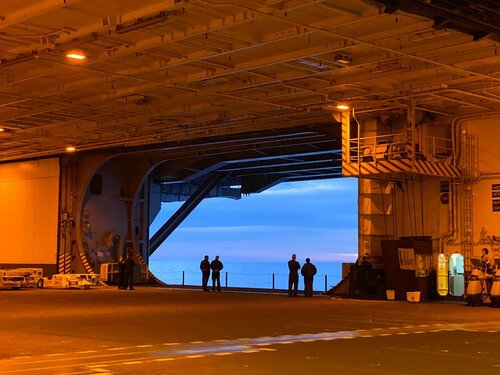Organizational Psychology - The US Navy & Performance Excellence
About the Author
Ben Foodman is a licensed psychotherapist & performance specialist. He owns his private practice located in Charlotte North Carolina where he specializes in working with athletes to help them overcome mental blocks (the yips), PTSD, ADD / ADHD and achieve flow states through the techniques of Brainspotting & Neurofeedback. If you are interested in services, use the link here! Enjoy the article below!
Table Of Contents
Introduction: Organizational Psychology & Tactical Athlete Mental Performance
Part I. Sport Psychology & Goal Setting For Tactical Athletes
Part II. Tactical Athlete Mental Performance, Arrested Landings & Catapult Launches
Part III. Physical & Mental Performance, Leadership & Navy Professional Athletes
Introduction: Organizational Psychology & Tactical Athlete Mental Performance
Back in January of 2020, I was invited along with several other individuals to take part in a civilian program hosted by the United States Navy. The purpose of this program is to educate civilians on daily operations of an aircraft carrier and the importance of the US Navy’s mission. However, this educational program doesn’t just take place in a classroom. Myself and several other civilians were lucky enough to be flown onto the USS Nimitz via a C-2 Greyhound cargo plane, experience an arrested landing, watch operations throughout the ship, and then leave the ship via catapult launch from the aircraft carrier! In this Training Report I wanted to show some of the incredible images taken during our visit, discuss how an aircraft carrier operates, and highlight how the sailors aboard the USS Nimitz define performance excellence. There are some important pieces of information to be aware of when trying to wrap your head around the immense nature of an aircraft carrier, so let’s go ahead and start with some important facts about the Navy’s mission and what a Carrier Strike Group is!
Part I. Sport Psychology & Goal Setting For Tactical Athletes
Many people may not be aware of this, but the U.S. Navy’s mission extends well beyond just protecting our country. The following direct excerpt from the official USS Nimitz home website is an explanation about how a carrier strike group functions and its’ overall mission: A carrier strike group (CSG) can be tasked to accomplish a variety of wartime missions, as well as missions other than war. During peacetime operations, a CSG typically conducts forward-presence operations to help shape the strategic environment, deter conflict, and build interoperability with allies. The U.S. Navy deploys a regular rotation of CSGs at an interval of six to eight months. The ships in the CSG are often dis-aggregated (spread out) from the carrier, performing missions hundreds or even thousands of miles away from the other ships. CSG missions include:
Power projection ashore against a wide range of strategic, operational, and tactical targets. A CSG has the ability to conduct long range aircraft strikes while land attack cruise missiles degrade and destroy enemy capabilities.
Freedom of the seas in international waters is achieved by gaining and maintaining sea control through the presence of and deterrence provided U.S. Navy vessels.
Provide long range and area defense for amphibious ready groups prior to and during operations.
The humanitarian assistance/disaster relief mission provides immediate and temporary assistance to countries and communities impacted by natural disasters.
Build and maintain a coherent and comprehensive common operational picture for government and military decision makers worldwide.
Build relationships and increase interoperability between nations by conducting multinational exercises and engagements with global allies and partners.
Provide a rapidly deployable combat force, capable of projecting air power at sea and ashore in order to meet specified military objectives.
In regards to the USS Nimitz, there are some fascinating facts to be aware of. First, the USS Nimitz was named after Chester William Nimitz (February 24, 1885-February 20th, 1966) who was a fleet admiral in the US Navy, and played a critical role in the naval history of World War II as commander in chief, U.S. Pacific Fleet and Commander in Chief, Pacific Ocean Areas, commanding allied air, land, and sea forces. The Nimitz is a nuclear powered, multi-mission aircraft carrier and is the oldest American aircraft carrier in active service. Another interesting fact is that the Nimitz has reverse osmosis (RO) desalinization capability and can produces up to 200,000 + gallons of drinkable water daily. Other quick important statistics about features of the ship include the following: it has two nuclear power plants; four main engines; four aircraft elevators; four catapults; four arresting gear cables; the Nimitz is 1092 feet long, 252 feed wide; the flight deck is approximately 4.5 acres full; weighs approximately 97,000 tons; accommodates 5000 sailors & marines; can reach speeds of 30 + knots; serves 18,000-20,000 meals per day; can hold 3.5 million gallons of fuel; and it can reach 23 stories high from the keel to the top of the mast. Now that we have reviewed some amazing facts about the USS Nimitz and CSG operations, I want to discuss what an arrested landing and catapult launch involve!
Part II. Tactical Athlete Mental Performance, Arrested Landings & Catapult Launches
Landing a plane on an aircraft carrier is called an arrested landing. During this process, the plane latches on to cable wires while landing on the aircraft carrier in order to rapidly decelerate the plane so it can safely stop on the ‘small’ landing area of the ship. As the Navy pilots are landing, they need to make sure the plane is accelerating so that if they are not able to catch the cables, they can quickly take off and circle back for another attempt. The description of an arrested landing experience was best described by the officer during the conclusion of our presentation before our flight, ‘don’t worry if you hear a loud metal scraping sound during the landing, or if it feels as though you are in a car crash, this is very normal. You might even feel as though you are taking off again, which means your plane did not catch the cable. This is very normal and you will attempt another landing”. As intense as this may sound, a catapult launch is just as formidable.
During a catapult launch the flight deck crew moves the plane into position behind the catapult and attaches the tow-bar on the plane's nose gear to a slot in the shuttle. When all elements that assist in a catapult are set (such as the jet blast deflectors, tow-bar, etc.) and safety checks are completed, the Catapult Officer makes the necessary checks to ensure that the plane is ready for launch. Once the catapult process actually begins, this system will launch a 45,000-pound plane from 0 to 170 miles per hour in two seconds! The speed and controlled chaos that is occurring during these moments demonstrates that there is nothing about an aircraft carrier that lacks intensity! As amazing as an arrested landing and catapult launch may sound, I believe you will be equally impressed with the team of individuals that make all of this possible, and why their actions demonstrate performance excellence.
Part III. Physical & Mental Performance, Leadership & Navy Professional Athletes
While members of the flight deck play a critical role in aircraft carrier operations, there is also an entire team of individuals that play a vital part in supporting the ship’s ability to effectively function by continuing to carry on the Navy’s tradition of performance excellence…As I mentioned earlier, the USS Nimitz is home to some 5000 sailors, all of whom have a wide variety of jobs including but not limited to mechanics, fire fighters, cooks, physical therapists, dentists, strength & conditioning coaches, engineers, nurses, mental health clinicians, lawyers, welders, fire fighters and many other types of professions. All of this is absolutely necessary towards maintaining flight operations. I point all of this out to emphasize that an aircraft carrier is a floating city that has many important moving pieces, all working towards the same goal despite the adverse conditions.
Part IV. Never Forget
In conclusion, while it’s easy to get distracted by F/A 18 Super Hornets launching off the deck, and the sheer size of an aircraft carrier, all of this is truly useless without the sailors. Of all the photographs taken during the tour, the picture below is the most important. This memorial located in the chief’s mess was a stark reminder that many Americans have paid the ultimate price in service to our country. Not only have American lives been lost through service in the Navy, but these individuals also end up being away from their loved ones for months on end, all for the purpose of keeping these ships operational so that we can maintain our freedoms here in the United States. After seeing this memorial I realized how insulated I am in the United States, and that it is too easy to go about my day completely unaware these events. I am grateful that the US Navy invited me to observe operations, learn about the hard work that these sailors do on a regular basis, and most importantly become more aware of the sacrifice that these individuals make for all of us here at home. Thank you for taking the time to read this and to learn more about the importance of the U.S. Navy!
Note To Reader:
If you are an athlete reading this segment of the TRAINING REPORT, hopefully this content was helpful! I put the Training Report together because I felt like many of the discussions on issues such as the Yips/mental blocks, strength training & other subject matter on athlete performance concepts were really missing the mark on these ideas (e.g. how trauma is the direct cause of the Yips). If you are interested in learning more, make sure to subscribe below for when I put out new content on issues related to sport psychology & athlete performance! Also, if you are looking to work with a mental performance specialist, you are in the right place! USE THIS LINK to reach out to me to see if my services are the right fit for your goals!
ARE YOU ON THE LIST?
Make sure you’re signed up to Ben’s mailing list to receive news & updates on new strategies in sport psychology, upcoming workshops & products. Don’t wait, sign up now!

















































